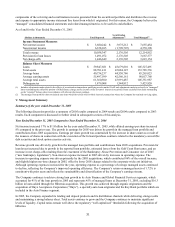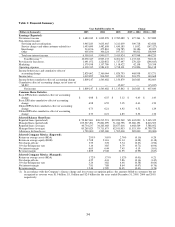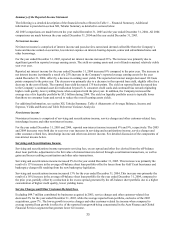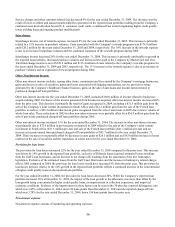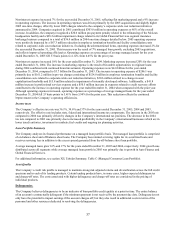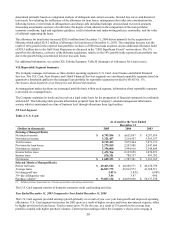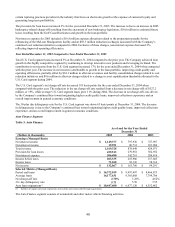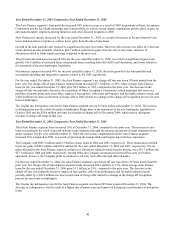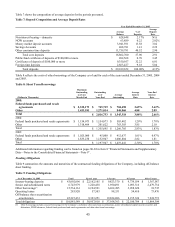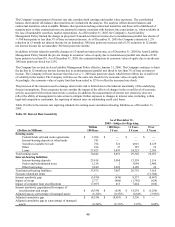Capital One 2005 Annual Report Download - page 50
Download and view the complete annual report
Please find page 50 of the 2005 Capital One annual report below. You can navigate through the pages in the report by either clicking on the pages listed below, or by using the keyword search tool below to find specific information within the annual report. ear Ended December 31, 2005 Compared to Year Ended December 31, 2004 Y
The Auto Finance segment’ s loan portfolio increased 64% year over year as a result of 2005 acquisitions of Onyx Acceptance
Corporation and the Key Bank non-prime auto loan portfolio, as well as, strong organic originations growth aided, in part, by
uto manufacturers’ employee-pricing initiatives and other discount programs in 2005. a
Auto Finance net income decreased for the year ended December 31, 2005, as a result of increases in the provision for loan
l sses and non-interest expense, as well as lower gains from the sale of auto loans. o
Growth in the loan portfolio also resulted in a significant increase in revenue. However, this increase was offset by a decrease
in non-interest income primarily related to $24.7 million reduction in gains from the sale of auto loans, inclusive of
llocations related to funds transfer pricing, compared to the prior year. a
The provision for loan losses increased 64% for the year ended December 31, 2005, as a result of significant organic loan
growth, $16.0 million of estimated future incremental losses resulting from the Gulf Coast Hurricanes, and losses related to
e enactment of the new bankruptcy legislation. th
Non-interest expense increased 48% for the year ended December 31, 2005, driven by growth in the loan portfolio and
incremental operating and integration expenses related to the 2005 acquisitions.
For the year ended, December 31, 2005, the Auto Finance segment’ s net charge-off rate was down 58 basis points from the
prior year. Net charge-offs of Auto Finance segment loans increased $77.1 million, or 25%, while average Auto Finance
loans for the year ended December 31, 2005 grew $4.9 billion, or 52%, compared to the prior year. The decrease in the
charge-off rate was primarily driven by the acquisition of Onyx Acceptance Corporation, which originates and services a
portfolio of mostly prime auto receivables, improved loan quality, collections performance and favorable industry trends, and
a $20.4 million one-time acceleration of charge-offs in 2004 related to a change in the charge-off recognition process for auto
ans in bankruptcy. lo
The 30-plus day delinquency rate for the Auto Finance segment was up 21 basis points at December 31, 2005. The increase
in delinquencies was the result of a spike in bankruptcy filings prior to the enactment of the new bankruptcy legislation in
October 2005 and the $20.4 million one-time acceleration of charge-offs in December 2004, which moved delinquent
accounts to charge-off status in that year.
Year Ended December 31, 2004 Compared to Year Ended December 31, 2003
Total Auto Finance segment loans increased 18% at December 31, 2004, compared to the prior year. The increase in auto
loans was primarily the result of growth in prime loans originated through the internet and growth in loans originated in the
dealer segment. For the year ended December 31, 2004, the net income contribution from the Auto Finance segment
creased 65% compared to 2003, as a result of growth in the loan portfolio and improving credit loss experience. in
The Company sold $901.3 million and $1.9 billion of auto loans in 2004 and 2003, respectively. These transactions resulted
in pre-tax gains of $40.3 million and $66.4 million for the years ended December 31, 2004 and 2003, respectively. Pre-tax
gains allocated to the Auto Finance segment, inclusive of allocations related to funds transfer pricing, were $41.7 million and
$57.3 million in 2004 and 2003, respectively. During 2004, the Company terminated its forward flow auto receivables
agreement; however, the Company plans to continue to sell auto receivables through other channels.
For the year ended December 31, 2004, the Auto Finance segment’ s net charge-off rate was down 134 basis points from the
prior year. Net charge-offs of Auto Finance segment loans decreased $54.8 million, or 15%, while average Auto Finance
loans for the year ended December 31, 2004 grew $1.5 billion, or 19%, compared to the prior year. The decrease in the
charge-off rate was primarily driven by improved loan quality, collections performance and favorable industry trends,
partially offset by a $20.4 million one-time acceleration of charge-offs related to a change in the charge-off recognition
rocess for auto loans in bankruptcy. p
The 30-plus day delinquency rate for the Auto Finance segment was down 205 basis points at December 31, 2004. The
decrease in delinquencies was the result of a higher mix of prime loans and improved delinquency performance of non-prime
l ans. o
41


